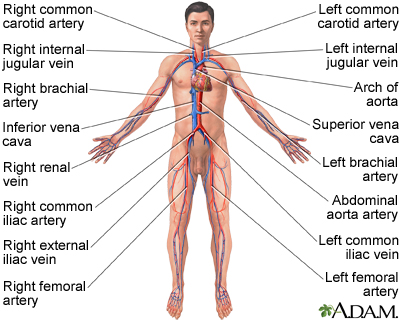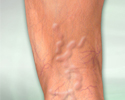Varicose veins
Varicosity
Varicose veins are swollen, twisted, and enlarged veins that you can see under the skin. They are often red or blue in color. They most often appear in the legs, but can occur in other parts of the body.
Causes
Normally, one-way valves in your leg veins keep blood moving up toward the heart. When the valves do not work properly, they allow blood to back up into the vein. The vein swells from the blood that collects there, which causes varicose veins.
Varicose veins are common, and affect more women than men. They do not cause problems for most people. However, if the flow of blood through veins becomes worse, problems such as leg swelling and pain, blood clots, and skin changes may be present.
Risk factors include:
- Older age
- Being female (hormonal changes from puberty, pregnancy, and menopause can lead to varicose veins, and taking birth control pills or hormone replacement can increase your risk)
- Being born with defective valves
- Obesity
- Pregnancy
- History of blood clots in your legs
- Standing or sitting for long periods of time
- Family history of varicose veins
Symptoms
Symptoms of varicose veins include:
-
Fullness, heaviness, aching, and sometimes
pain in the legs
Pain in the legs
Leg pain is a common problem. It can be due to a cramp, injury, or other cause.
 ImageRead Article Now Book Mark Article
ImageRead Article Now Book Mark Article - Visible, swollen veins
- Smaller veins that you can see on the surface of the skin, called spider veins.
- Thigh or calf cramps (often at night)
-
Mild
swelling of feet or ankles
Swelling of feet or ankles
Painless swelling of the feet and ankles is a common problem, especially among older people. Abnormal buildup of fluid in the ankles, feet, and legs ...
 ImageRead Article Now Book Mark Article
ImageRead Article Now Book Mark Article - Itching
If flow of blood through the veins becomes worse, symptoms may include:
- Leg swelling
- Leg or calf pain after sitting or standing for long periods
- Skin color changes of the legs or ankles
- Dry, irritated, scaly skin that can crack easily
- Skin sores (ulcers) that do not heal easily
- Thickening and hardening of the skin in the legs and ankles (this can happen over time)
Exams and Tests
Your health care provider will examine your legs to look for swelling, changes in skin color, or sores. Your provider also may:
- Check blood flow in the veins
- Rule out other problems with the legs (such as a blood clot)
Treatment
Your provider may suggest that you take the following self-care steps to help manage varicose veins :
Manage varicose veins
Venous insufficiency - self-care; Venous stasis ulcers - self-care; Lipodermatosclerosis - self-care
-
Wear
compression stockings
to decrease swelling. These stockings gently squeeze your legs to move blood up towards your heart.
Compression stockings
Compression hose; Pressure stockings; Support stockings; Gradient stockings; Varicose veins - compression stockings; Venous insufficiency - compressi...
 ImageRead Article Now Book Mark Article
ImageRead Article Now Book Mark Article - DO NOT sit or stand for long periods. Even moving your legs slightly helps keep the blood flowing.
- Raise your legs above your heart 3 or 4 times a day for 15 minutes at a time.
- Care for wounds if you have any open sores or infections. Your provider can show you how.
- Lose weight if you are overweight.
- Get more exercise. This can help you keep off weight and help move blood up your legs. Walking or swimming are good options.
- If you have dry or cracked skin on your legs, moisturizing may help. However, some skin care treatments can make the problem worse. Talk to your provider before using any lotions, creams, or antibiotic ointments. Your provider can recommend lotions that can help.
If only a small number of varicose veins are present, the following procedures may be used:
-
Sclerotherapy
. Salt water or a chemical solution is injected into the vein. The vein hardens and disappears.
Sclerotherapy
Varicose veins are swollen, twisted, painful veins that have filled with blood.
Read Article Now Book Mark Article - Phlebectomy. Small surgical cuts are made in the leg near the damaged vein. The vein is removed through one of the cuts.
If the varicose veins are larger, longer, or more widespread on the leg, your provider will suggest one of the following:
-
Procedures that can be done in a provider's office or clinic, such as using a
laser or radiofrequency
Laser or radiofrequency
Varicose veins are swollen, twisted, painful veins that have filled with blood.
Read Article Now Book Mark Article - Varicose vein stripping, used to remove or tie off a large vein in the leg called the superficial saphenous vein.
Outlook (Prognosis)
Varicose veins tend to get worse over time. Taking self-care steps can help relieve achiness and pain, keep varicose veins from getting worse, and prevent more serious problems.
When to Contact a Medical Professional
Call your provider if:
- Varicose veins are painful.
- They get worse or do not improve with self-care, such as by wearing compression stockings or avoiding standing or sitting for too long.
- You have a sudden increase in pain or swelling, fever, redness of the leg, or leg sores.
- You develop leg sores that do not heal.
References
Freischlag JA, Heller JA. Venous disease. In: Townsend CM Jr, Beauchamp RD, Evers BM, Mattox KL, eds. Sabiston Textbook of Surgery . 20th ed. Philadelphia, PA: Elsevier Saunders; 2017:chap 64.
Iafrati MD, O'Donnell TF. Varicose veins: Surgical treatment. In: Cronenwett JL, Johnston W, eds. Rutherford's Vascular Surgery . 8th ed. Philadelphia, PA: Elsevier Saunders; 2014:chap 57.
Kabnick LS, Sadek M. Varicose veins: endovenous ablation and sclerotherapy. In: Cronenwett JL, Johnston KW, eds. Rutherford's Vascular Surgery . 8th ed. Philadelphia, PA: Elsevier Saunders; 2014:chap 58.
-
Varicose veins
Animation
-
Varicose veins - illustration
Varicose veins are enlarged, twisted, painful superficial veins resulting from poorly functioning valves. Varicose veins usually occur in the veins of the legs, although it may occur elsewhere. It is a common condition, affecting mostly women.
Varicose veins
illustration
-
Circulatory system - illustration
Blood used by the body is brought back to the heart and lungs by the veins of the body. Once the blood has gathered more oxygen from the lungs, it is pumped back out to the body through the arteries.
Circulatory system
illustration
-
Varicose veins - illustration
Varicose veins are enlarged, twisted, painful superficial veins resulting from poorly functioning valves. Varicose veins usually occur in the veins of the legs, although it may occur elsewhere. It is a common condition, affecting mostly women.
Varicose veins
illustration
-
Circulatory system - illustration
Blood used by the body is brought back to the heart and lungs by the veins of the body. Once the blood has gathered more oxygen from the lungs, it is pumped back out to the body through the arteries.
Circulatory system
illustration
-
Varicose veins
(Alt. Medicine)
Review Date: 6/6/2016
Reviewed By: Deepak Sudheendra, MD, RPVI, Assistant Professor of Interventional Radiology & Surgery at the University of Pennsylvania Perelman School of Medicine, with an expertise in Vascular Interventional Radiology & Surgical Critical Care, Philadelphia, PA. Review provided by VeriMed Healthcare Network. Also reviewed by David Zieve, MD, MHA, Isla Ogilvie, PhD, and the A.D.A.M. Editorial team.





